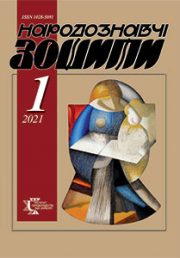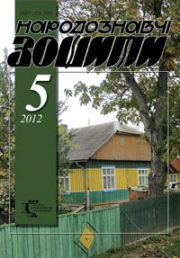The Ethnology Notebooks. 2023. № 4 (172), 986—994
UDK [[392.81:398.332.4]:392.5](=161.2)
DOI https://doi.org/10.15407/nz2023.04.986
RITUAL FOOD IN ONEIROMANTIC PRACTICES OF UKRAINIANS
SEREBRYAKOVA Olena
- ORCID ID: https://orcid.org/0000-0002-1039-2920
- Candidate of Historical Sciences (= Ph.D. in History),
- Senior researcher of the department of Modern Ethnology
- of the Ethnology Institute
- of the National Academy of Sciences of Ukraine,
- 15, Svobody Avenue, 79000, Lviv, Ukraine,
- Contacts: e-mail: o-sereb@ukr.net
Abstract. The aim of the offered article is coverage of the layer of customary and ritual, worldview phenomena associated to divination about the future husband (wife) with the help of ritual food.
The object of the research is the traditional worldview, the customs and rite culture of the residents of different regions of Ukraine, and the subject — fortune-telling with ritual food to induce prophetic dreams about the bridegroom (bride), which Ukrainians resorted to during various winter calendar holidays (Introduction to the Church of the Most Holy Theotokos, Saint Catherine, Andrew, New Year). Attention is paid to the assortment of «prophetic» food and its recipe, the time, venue and composition of the divination performers have been established, the action and verbal levels of oneiromantic practices are revealed. Local differences, beliefs, customary instructions, ritual taboos etc., related to the prediction the person, appearance of the future husband (wife) etc. are characterized. Archaic ways of using and obtaining ingredients were identified and studied in detail, for example, for making ritual cookies (pulling bushes, «riding», «jumping» on a «prophetic» peg, using «silent» water brought from the river, wells in the mouth). In this sense, the fact that ritual food was a kind of mediator between «this» and «another» world, from where «prophetic» information came, is interesting. It should be noted that in some places girls and boys could foresee their marriage fate only if certain conditions were met, which actually preceded oneiromantic practices. It was noted that in some cases, oneiromantic practices were combined with fortune-telling with seeds, stakes, the custom of «biting the kalyta» and were a kind of continuation or completion of them. In addition, in order to increase the effectiveness of the rituals, Ukrainian youth used proverbs, prayers as well as clothes and some household items that could be intentionally steal. Mythologically marked places are important, which were associated with the location and connection to the «other» world of the souls of ancestors, household spirits, etc.
The basis of the article are the materials of the field research, local folklore articles and works of the second half of the nineteenth and the beginning of the twenty-first centuries.
The methodology of this work is based on general scientific methodological principles and the basic requirements that apply to the works of historical and ethnological direction. The author uses a various methods (field observation, comparative-historical, comparative, reconstructive, structural-semantic).
Keywords: mantic actions/practices (divination), Ukrainians, ritual food, water, salt, pegs, clothes, towel, spoon.
Received 9.06.2023
REFERENCES
- Serebriakova, O. (2022). Marriage divinations in the calendar rituals of Ukrainians [in Ukrainian].
- Archive of the Institute of Ethnology of the National Academy of Sciences of Ukraine (Archive of the IN NANU). F. 1. Op. 2. Od. save 658 [in Ukrainian].
- Skrypnyk, H. (Ed.). (2016). Ethnographic image of modern Ukraine. Corps of expeditionary folklore and ethnographic materials. Calendar rituals (Vol. 6). NAN of Ukraine; IMFE named after M.T. Rylsky. Kyiv [in Ukrainian].
- Archive of the IN NANU. F. 1. Op. 2. Od. save 704 [in Ukrainian].
- Mashkarynets’, V. (1930). Beliefs on some holidays in the village of Kalnyk. Subcarpathian Russia (Part 1—2, pp. 22—25). Uzhhorod [in Ukrainian].
- Varkhol, J. (1988). Girls fortune-telling during the winter solstice. Naukovyj zbirnyk muzeiu ukrains’koi kul’tury u Svydnyku (Vol. 15, book 1, pp. 163—172). Priashiv: Muzej ukrains’koi kul’tury [in Ukrainian].
- Kis’, R., & Maierchyk, M. (1998). The agrarian layer of the archaic rituals of the Carpathians (reasons for the reconstruction of ethnogenetic processes). Ethnology notebooks, 3, 274—278 [in Ukrainian].
- Pasternak, Ya. (1929). Customs and beliefs in the village Zibolkah, Zhovkva district. Materiialy do etnolohii j antropolohii (Vol. 21—22, part 1, pp. 321—352). L’viv: Z drukarni Naukovoho tovarystva imeni Shevchenka [in Ukrainian].
- Koperzhynsky, K. (1929). Calendar of folk rites of the New Year cycle. Original citizenship and its remnants in Ukraine (Issue 3, pp. 14—97). Kyiv [in Ukrainian].
- Archival scientific collections of manuscripts and audio recordings of M.T. Rylsky Institute of Art Studies, Folklore and Ethnology of the National Academy of Sciences of Ukraine (ASCMA IMFE NAN of Ukraine). F. 14—5. Act. 50 [in Ukrainian].
- Chubinsky, P.P. (Ed.). (1872). Folk diary. Proceedings of the ethnographic-statistical expedition to the Western Russian region, equipped by the Imperial Russian Geographical Society: materials and research (Vol. 3). Sankt-Peterburg [in Russian].
- Artiukh, L. (1993). The village of Tovstenke yesterday and today. Narodna tvorchist’ ta etnohrafiia, 2, 73—77 [in Ukrainian].
- Papizh, V. (1980). Some religious rites and customs of Pidgaiechchyna. Pidhaiets’ka zemlia: istoryko-memuarnyj zbirnyk. N’iu-Jork; London; Paryzh; Sydnej; Toronto; Kyiv [in Ukrainian].
- Archive of the IN NANU. F. 1. Op. 2. Od. save 782 [in Ukrainian].
- Kopernicki, I. (1887). The sketch to the ethnography of the Ruthenians in Volyn from the materials collected by mrs. Zofija Rokossowska in the village Yurkivshchyzna. Zbior wiadomosci do antropologii krajowej (Vol. 11, pp. 130—228) [in Polish].
- Petrov, N. (1871, september). About folk holidays in southwestern Russia. Trudy Kyevskoj dukhovnoj akademyy [in Russian].
- Markevich, N.A. (Ed.). (1991). Customs, beliefs, cuisine and drinks of Ruthenians. Kyiv: Dobrovol’noye obshchestvo lyubiteley knigi URSR [in Russian].
- Mojsej, A.A. (2008). Magic and mantic in the folk calendar of the East-Romanian population of Bukovina. Chernivtsi [in Ukrainian].
- Makovij, H.P. (1993). Trampled flower: ethnographic stories. Kyiv: Ukr. pys’mennyk [in Ukrainian].
- Archive of the IN NANU. F. 1. Op. 2. Od. save 513 [in Ukrainian].
- Ben’kovskiy, I. (1895, december). Maiden Feast of St. Andrew. Kiyevskaya starina (Vol. 51, book 12, pp. 100—103). Kyiv: Tipografнya G.T. Korchak-Novitskago [in Russian].
- Archive of the IN NANU. F. 1. Op. 2. Od. save 698 [in Ukrainian].
- Ivanov, P. (1907). Life and beliefs of the peasants of the Kupyansk district, Kharkov province. Sbornik Har’kovskogo istoriko-filologicheskogo obshhestva (Vol. 17). Kharkov: Pechatnoye Delo [in Russian].
- Dykarev, M. (1905). People’s calendar of Valuysky district (Borysiv volost) in Voronezh region. Materialy do ukrains’ko-rus’koi etnol’ogii (Vol. VI, pp. 113—204). Lviv [in Ukrainian].
- Shukhevych, V.O. (1999). Hutsulshchyna (Part 4).Second edition. Verkhovyna: Hutsul’schyna [in Ukrainian].
- Archive of the IN NANU. F. 1. Op. 2. Od. save 659 [in Ukrainian].
- Archive of the IN NANU. F. 1. Op. 2. Od. save 281 [in Ukrainian].
- (2005). Ukraine and Ukrainians: types, landscapes, everyday life: a set of 30 gift postcards-pictures from the funds of the «Ivan Honchar Museum». Kyiv: Oranta [in Ukrainian].
- Kosiv photo album. Postcards and photographs of the Hutsul Region in the 1920 s and 1930 s years [in Ukrainian].
- Kravchenko, V. (Ed.). (1920). Customs in the village of Zabriddya and in some other localities not far from this village in Zhytomyr County in Volyn. Zhytomyr: Robitnyk [in Ukrainian].
- ASCMA IMFE NAN of Ukraine. F. 14—3. Act. 1072 [in Ukrainian].
- Kutel’makh, K.M. (1999). Agrarian motifs in the calendar rituals of the inhabitants of Polissia. Polissia Ukrainy: materialy istoryko-etnohrafichnoho doslidzhennia. Ovruchchyna 1995 (Issue 2, pp. 191—210). Lviv [in Ukrainian].
- Archive of the IN NANU. F. 1. Op. 2. Od. save 588 [in Ukrainian].
- Archive of the IN NANU. F. 1. Op. 2. Od. save 787 [in Ukrainian].
- Mushynka, M. (1988). Spiritual culture. Lemkivschyna: Zemlia — liudy — istoriia — kul’tura. N’iu-Jork; Paryzh; Sydnej; Toronto [in Ukrainian].
- Archive of the IN NANU. F. 1. Op. 2. Od. save 663 [in Ukrainian].
- Skoropad, V. (1993). My memories. Litopys Borschivschyny: Istoryko-kraieznavchyj zbirnyk (Issue 3). Borschiv: Chumats’kyj shliakh [in Ukrainian].
- Osyka, M. (1972). From our folklore. Buchach i Buchachchyna: Istorychno-memuarnyj zbirnyk. N’iu-Jork; London; Paryzh; Sydnej; Toronto [in Ukrainian].
- Archive of the IN NANU. F. 1. Op. 2. Od. save 568. Arc. 1—106 [in Ukrainian].







